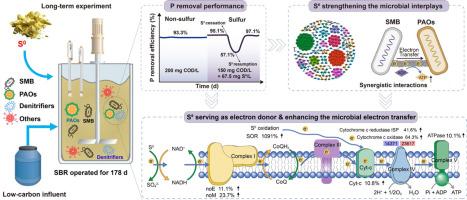Elemental sulfur enhances autotrophic denitrifying phosphorus removal from carbon-deficient wastewater through microbial synergy and electron transfer optimization
IF 12.4
1区 环境科学与生态学
Q1 ENGINEERING, ENVIRONMENTAL
引用次数: 0
Abstract
The deficient organic carbon sources frequently constrain biological phosphorus removal in urban wastewater treatment. While elemental sulfur (S0) serves as an economical electron donor for autotrophic denitrification, its capacity to offer supplementary electron donor to enhance denitrifying phosphorus removal (DPR) under carbon-deficient conditions (< 200 mg COD/L) remains unexplored. To address this gap, a long-term reactor with and without S0 supplementation was operated for 178 days. Results demonstrated that S0 effectively replaced partial carbon demand, elevating phosphorus removal efficiency from 93.3% (200 mg COD/L) to 95.1% under carbon-deficient conditions (150 mg COD/L + 67.5 mg/L S0). Sulfur conversion analysis revealed heightened S0 utilization during carbon limitation, corroborated by typical cycle tests. Microbial analyses indicated S0 enrichment of community richness (Ace: +1.14%) and diversity (Shannon: +2.0%), while molecular ecological networks exhibited enhanced complexity (connectance: +100%) and stability (robustness: +100∼206.3%). Crucially, S0 amplified synergistic interactions between polyphosphate-accumulating organisms (PAOs; Rhodobacteraceae, Dechloromonas, Sediminibacterium) and sulfur-driven denitrifiers (Terrimonas, Arenimonas). Random forest analysis confirmed S0-mediated upregulation of key functional genes: phosphorus metabolism (ppk, ppx), sulfur oxidation (soxB, dsrA), and electron transfer (nuoF, coxA, cytc), thereby optimizing electron flux and ATP synthesis for metabolic demands. This work establishes an S0-assisted DPR strategy that leverages synergistic microbial partnerships and enhanced electron transport to overcome carbon deficiency in wastewater treatment.

单质硫通过微生物协同作用和电子转移优化增强了自养反硝化除磷能力
在城市污水处理中,有机碳源缺乏往往制约生物除磷。单质硫(S0)作为一种经济的自养反硝化电子供体,其在缺碳条件下(≤200mg COD/L)作为辅助电子供体提高反硝化除磷(DPR)的能力尚不明确。为了解决这一差距,一个长期反应堆在添加和不添加硫的情况下运行了178天。结果表明,在缺碳条件下(150 mg COD/L + 67.5 mg/L S0), S0能有效替代部分碳需求,将磷去除率从93.3% (200 mg COD/L)提高到95.1%。硫转化分析表明,在碳限制过程中,硫的利用率提高,这一点得到了典型循环试验的证实。微生物分析表明,群落丰富度(Ace: +1.14%)和多样性(Shannon: +2.0%)增加了50倍,而分子生态网络的复杂性(连通性:+100%)和稳定性(鲁棒性:+100 ~ 206.3%)得到了增强。至关重要的是,S0放大了聚磷生物(PAOs; Rhodobacteraceae, decchloromonas, Sediminibacterium)和硫驱动的反硝化菌(Terrimonas, Arenimonas)之间的协同作用。随机森林分析证实了50介导的关键功能基因:磷代谢(ppk, ppx),硫氧化(soxB, dsrA)和电子传递(nuoF, coxA, cytc)的上调,从而优化了电子通量和ATP合成以满足代谢需求。这项工作建立了一个50辅助的DPR策略,利用协同微生物伙伴关系和增强的电子传递来克服废水处理中的碳缺乏。
本文章由计算机程序翻译,如有差异,请以英文原文为准。
求助全文
约1分钟内获得全文
求助全文
来源期刊

Water Research
环境科学-工程:环境
CiteScore
20.80
自引率
9.40%
发文量
1307
审稿时长
38 days
期刊介绍:
Water Research, along with its open access companion journal Water Research X, serves as a platform for publishing original research papers covering various aspects of the science and technology related to the anthropogenic water cycle, water quality, and its management worldwide. The audience targeted by the journal comprises biologists, chemical engineers, chemists, civil engineers, environmental engineers, limnologists, and microbiologists. The scope of the journal include:
•Treatment processes for water and wastewaters (municipal, agricultural, industrial, and on-site treatment), including resource recovery and residuals management;
•Urban hydrology including sewer systems, stormwater management, and green infrastructure;
•Drinking water treatment and distribution;
•Potable and non-potable water reuse;
•Sanitation, public health, and risk assessment;
•Anaerobic digestion, solid and hazardous waste management, including source characterization and the effects and control of leachates and gaseous emissions;
•Contaminants (chemical, microbial, anthropogenic particles such as nanoparticles or microplastics) and related water quality sensing, monitoring, fate, and assessment;
•Anthropogenic impacts on inland, tidal, coastal and urban waters, focusing on surface and ground waters, and point and non-point sources of pollution;
•Environmental restoration, linked to surface water, groundwater and groundwater remediation;
•Analysis of the interfaces between sediments and water, and between water and atmosphere, focusing specifically on anthropogenic impacts;
•Mathematical modelling, systems analysis, machine learning, and beneficial use of big data related to the anthropogenic water cycle;
•Socio-economic, policy, and regulations studies.
 求助内容:
求助内容: 应助结果提醒方式:
应助结果提醒方式:


